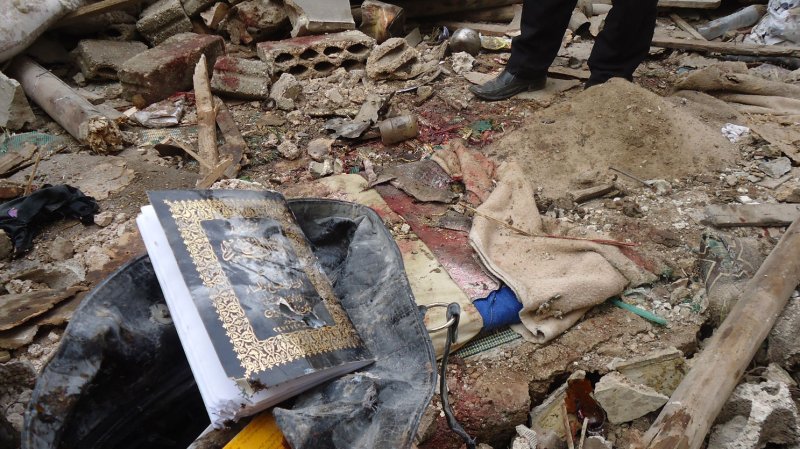A copy of the Muslim holy book Koran is seen amidst rubble after an Alawite-led attack on Homs, Syria in February 2012. UPI |
License Photo
BEIRUT, Lebanon, July 23 (UPI) -- There are growing signs that Syrian President Bashar Assad is setting up strongholds for his minority Alawite sect in their ancestral lands in northwestern Syria, where they will presumably dig in as the country Syria dissolves amid a 17-month-old revolution -- or make a last stand.
Assad seems determined to fight on and his forces appear to be driving rebel forces out of Damascus after more than a week of fierce street battles during which four of the president's key security chiefs were assassinated in a bombing.
But there's a growing belief, largely based on a series of recent military operations by Assad's forces, mainly Alawites who're the pillars of his minority regime, to consolidate Alawite regions in coastal Latakia province where he can count on the populace as rebel forces take territory.
"It appears to be a matter of time before Alawite-dominated forces fighting in Damascus begin their retreat," global intelligence consultancy Stratfor observed from Texas.
Alawites, an offshoot of Shiite Islam, comprise around 12 percent of Syria's population of 22 million.
The mainstream Sunni sect, which forms 75 percent, has been subjugated by the regime since it was established in a 1970 military coup by Assad's late father, Hafez Assad, known as "the Lion of Damascus."
Many Alawites have become convinced the regime can no longer be sustained, although exactly where Assad stands in all this is unclear, and see themselves fighting what they deem to be an existential battle.
They're moving in considerable numbers to Latakia province. Many are fleeing into Lebanon to the west through the Bekaa Valley, controlled by Assad's ally Hezbollah, and then into an Alawite corridor running north along the Mediterranean coast to Latakia.
They're unable to move directly north to Latakia because rebel forces of the Free Syrian Army hold territory between Damascus and the Alawites homeland.
Security sources estimate that more than half of these 30,000 Syrians, mainly from Damascus, who have surged into north Lebanon over the last week are Alawites heading north to their heartland where they confined themselves through centuries of Mamluke and Ottoman rule.
Many of these are believed to be defectors from the Syrian military. Large numbers have crossed into Turkey to make their way to the Latakia stronghold, where the Assad clan's hometown of Qardaha is tucked away in the mountains.
"The inability of Bashar al-Assad's forces to hold predominantly Sunni areas and recent massacres point to the fragmentation of Syria," the Financial Times reported.
Regime forces launched ferocious attacks on Sunni-dominated regions along the Alawite corridor running up the coast from Lebanon to Turkey in what appeared to be a systematic effort to consolidate control of this strategic strip.
The towns of Tremesh, Rastan and Houla were the main targets. Mass killings were carried out there to drive out non-Alawites, including large numbers of Christians.
The pattern seems to be to destroy Sunni towns and villages on the periphery of the Alawite heartland east of Latakia.
Regime stalwarts seem to believe they have a better chance of survival by consolidating Alawite strength in one defensible mountainous region rather than stretching it out across the country, many parts of which are dominated by other minority sects like the Kurds and the Druze.
But this remains a risky option that would leave the Alawites with nowhere to go but the Mediterranean if things go badly, as they may well do as the rebels gain strength.
It seems unlikely in that event that most Alawites would be able to get away. But the heavily guarded Russian naval base at Tartus could be the ultimate escape hatch for Assad, his family and his key henchmen.
The presidential jet was reported in the port city of Latakia last week, although Assad's believed to be in Damascus. There are reports his wife and mother, with other close relatives, are in Tartus.
"The resurrection of an Alawi state could be catastrophic," the Financial Times said.
"First it would be a heavily armed rogue regime that would continue to act as a proxy for Iran and guarantee Russia a deep-water Mediterranean naval base at Tartus."
It would also "act as a catalyst to spread the conflict into northern Lebanon and Turkey, whose population includes approximately half a million Arab Alawites along with perhaps 20 million Turkish Alawites.





